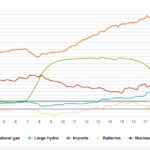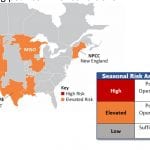Stricken by repeated extreme heat events, the prospect of a worsening drought, incremental resource delays, and the “unforeseen” loss of 300 MW in thermal resources, California has set out to secure additional energy resources to ensure reliability this summer.
Responding to a June 29 letter from the California Public Utilities Commission (CPUC) and the California Energy Commission (CEC), the California Independent System Operator (CAISO) on July 1 declared a “significant event” and used its backstop capacity procurement mechanism (CPM) authority to issue a solicitation for additional capacity during the months of July, August, and September. However, CAISO officials in a July 2 call suggested the significant event may last through October.
CAISO’s declaration of a CPM significant event is notable because it means the grid operator has determined that current conditions are “materially different” from assumptions it used to determine resource adequacy capacity requirements—and that those conditions threaten the grid’s reliability. While CAISO uses the authority sparingly, it declared a similar event last summer during an intense heatwave when it was forced to implement periods of rotating blackouts in various places throughout the state on Aug. 14 and 15.
“It is an important part of our tool kit and an essential backstop to ensure a balance of demand and supply on California’s electric grid,” the grid operator said last week. “As these early heat events telegraph, the grid will be more strained than anticipated this summer due to record-breaking climate change impacts across the West and elsewhere. The ISO’s decision to seek additional capacity is another necessary step we can take to be adequately prepared.”
CPUC, CEC: Measures Responding to Last Summer’s Outages Not Enough
In their letter to CAISO CEO Elliot Mainzer in late June, CPUC President Marybel Batjer and CEC Chair David Hochschild acknowledged the state has taken several critical actions to implement recommendations from the entities’ jointly issued October 2020 preliminary root cause analysis of the August 2020 outages—but that new pressures were causing “a material change in system conditions.”
Among the state’s recent efforts to address summer reliability is a Feb. 11–issued decision (D.21-02-028) by the CPUC that directed the state’s three largest investor-owned utilities (IOUs)—Pacific Gas and Electric (PG&E), Southern California Edison, and San Diego Gas & Electric—to contract for additional capacity to serve peak and net peak demand this summer. That decision, pivotally, allowed the utilities to source incremental capacity from existing power plant efficiency upgrades; revised power purchase agreements; contracts for generation that is at risk of retirement; incremental energy storage capacity; and “firm” forward imported energy. And while that order did not specify a megawatt procurement target, the CEC said it has “expeditiously reviewed and approved incremental capacity at jurisdictional gas plants to support this procurement.”
In March, meanwhile, the CPUC adopted another decision, D.21-03-056, which funded a statewide Flex Alert program, as well as directed IOUs to collectively procure at least 1 GW and up to 1.5 GW of incremental resources to provide power during peak and net peak hours, and effectively increased the planning reserve margin to 17.5% (and potentially 19%) from 15%.
California Facing Drought, Thermal Power Loss, Repeated Extreme Heat Events
However, despite these efforts, “conditions have dramatically changed in the past month,” and tackling them will need “every tool that is available to the state to be deployed to ensure reliability this summer,” the CPUC and CEC warned.
Of most concern is that the West is facing a severe drought that has reduced hydro capacity by about 1 GW, they said. While CAISO in its May-issued 2021 Summer Loads and Resources Assessment (SLRA) warned that hydro conditions would be “below normal,” resource conditions have quickly deteriorated. At Lake Oroville, for example, the state’s second-largest reservoir, water levels have fallen to 30% of capacity, and the California Department of Water Resources warned the water could be so low in a few months that the Butte County reservoir’s hydroelectric generating plant may be forced to shut down for the first time.
The CEC and CPUC also said natural gas power resources have declined. “Due to unforeseen circumstances, at least 300 MW of thermal capacity will not be available this summer,” it noted. At the same time, the state is facing critical incremental resource delays. “The CPUC recently received notice that several will be delayed by one to several months, and in some cases will push online dates past the summer window,” it noted.
Meanwhile, though the CPUC planned for development of demand-side resources in its March order, participation is “uncertain,” the agency said. “While the CPUC and CEC are working to ensure full enrollment in new programs, it appears that savings from the program will be less than targeted in the decision.”
Compounding all these factors are that California has already faced repeated high heat events. CAISO issued its first Flex Alert and grid warning on June 17 and 18, prompting Gov. Gavin Newsom to sign an emergency proclamation to free up additional energy capacity and plead for conservation. An extreme heatwave that hit the Pacific Northwest in late June, meanwhile, prompted CAISO to issue a heat bulletin that projected potential resource shortfalls, owing in part to “less energy” that may be available “across the West for sharing.”
According to a memorandum CAISO CEO Mainzer issued on July 7, the “early, widespread heat events during the last days of spring and first week of summer indicate that the prevailing pattern of extreme temperatures, drought and declining hydro conditions is likely to extend across the summer, increasing the probability of stressed grid conditions.”
A Glaring Problem: How to Best Meet Net Peak
One significant factor compounding the grid’s constraints is that while California’s resource adequacy program has historically focused on procuring enough resources to meet gross load peak requirements, fielding a potential supply gap between the hours of 4 p.m. and 9 p.m. is proving more challenging, particularly during periods of extreme heat. Resources used to meet gross peak “are not adequately supporting net peak in extreme conditions,” the heads of the CEC and CPUC acknowledged in their letter.
“More recent decisions have begun to focus on the need to meet peaks at multiple hours of the day and new resource build-outs are focused on meeting both peak and net peak demands. However, because of the conditions discussed above, including the fact that much of these resources will not be online to support reliability in 2021, there is a need for additional procurement to support net peak,” they said.
According to CAISO officials Mark Rothleder, vice president and chief operating officer, and Neil Millar, vice president of Infrastructure and Operations Planning, a response is urgent. “The assumption that a suitable planning reserve applied at the time of peak load would provide reliability 24/7 is no longer valid due to changing conditions across the day and the implications of the net peak later in the day,” the officials warned last week. “The other risk factors outlined increase the need to address the change in these assumptions immediately.”
The officials urged scheduling coordinators with non-resource adequacy capacity that is available and willing to receive a “significant event” CPM designation to contact the ISO through a Customer Inquiry, Dispute and Information (CIDI) ticket as soon as possible, “and preferably by July 7.” A tentative timeline suggests CAISO intends to designate available capacity for 30-day terms (with possible 60-day extensions) around July 9. “In addition to submitting a CIDI ticket, parties with capacity available to meet this significant event should also submit offers to the intra-monthly [CPM competitive solicitation process (CSP)] for August, September, and October,” the grid operator said.
As it reviews these responses, however, the ISO “remains hyper focused on reliable operations using all available tools, with a continued focus on outage management, effective communication, and deployment of Flex Alerts as necessary,” Mainzer told CAISO’s Board of Governors on Wednesday. “We have stood up an Incident Command light structure within the ISO and will continue to provide 7-day advance communication on the potential for stressed grid conditions, including heat bulletins where appropriate and targeted outreach to our key operational partners and stakeholders,” he said.
Looking Ahead: CPUC Orders 11.5 GW Through 2026
Despite its present uncertainties, California’s regulators appear confident about progress on long-term procurement. On June 24, the CPUC issued what it called a “historic decision” that directed all load-serving entities (LSEs) to procure 11.5 GW of new power resources that should come online between 2023 and 2026. It will essentially require capacity additions of 2 GW by 2023, an additional 6 GW by 2024, an additional 1.5 GW by 2025, and an additional 2 GW by 2026.
The CPUC’s measure last month is partly rooted in the state regulator’s 2020-initiated effort to ensure enough capacity to replace 3,700 MW from natural gas generators, which are expected to retire owing to California’s once-through-cooling rules, and 2,700 MW from PG&E’s two Diablo Canyon nuclear reactors, which are slated to go offline in 2024 and 2025. The CPUC specifically ordered 2.5 GW of zero-emitting resources to replace Diablo Canyon’s generation, along with generation paired with storage, or demand response resources, but it said that all resources that LSEs can procure “will be zero-emitting, unless they otherwise qualify under the renewables portfolio standard eligibility requirements.” That may include 1 GW of new geothermal resources, as well as 1 GW of long-duration (8 hours or more) storage resources, which the CPUC envisioned should come online by 2025. It may also include some biomass.
The June order adds to the CPUC’s November 2019 procurement order for 3.3 GW that is slated to come online between 2021 and 2023. In addition, under California’s 2010-enacted Assembly Bill 2514, 1,325 MW of energy storage are required. An estimated 1,500 MW is expected to be procured as part of the CPUC’s Feb. 2021 extreme weather reliability rule.
The CPUC, meanwhile, confirmed that 4,000 MW is already contracted to come online between June 2021 and August 2024, resources that are associated with other state energy programs such as the state’s Renewables Portfolio Standard (RPS), which requires all the state’s electricity to come from carbon-free resources by 2045. According to the CPUC, the state’s large IOUs in 2020 had an RPS retail percentage of 43%. Small and multi-jurisdictional utilities had a 29% RPS retail load, while community choice aggregators had an RPS retail load of 41%.
—Sonal Patel is a POWER senior associate editor (@sonalcpatel, @POWERmagazine)










